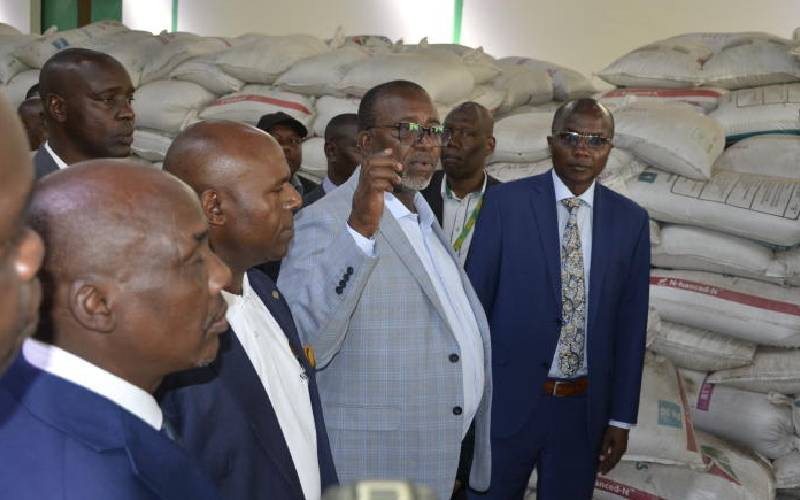
Agriculture and manufacturing remained the key growth drivers as the country's economy grew by 5.3 per cent last year.
According to the Economic Survey 2015 released yesterday, Agriculture accounted for 27.3 per cent of the GDP last year, more than two times what the manufacturing sector injected into the economy.
The report, however, notes that the agricultural sector grew at a decelerated rate of 3.5 per cent from a revised Sh795 billion in 2013 to Sh822 billion in 2014.
Devolution and Planning Cabinet Secretary Anne Waiguru blamed depressed rainfall for the decline.
"The agricultural sector recorded mixed performance mainly attributable to erratic rains, with some regions experiencing depressed rainfall. The value of marketed agricultural production at current prices declined from Sh334.8 billion in 2013 to Sh333.2 billion in 2014," said Ms Waiguru.
Maize, wheat and sugarcane registered reduced production in 2014, while tea, coffee and rice production increased. Maize production declined by 4.2 per cent to 39 million bags in the year under review, while wheat production decreased from 4.6 million bags in 2013 to 3.1 million bags last year.
The report notes that rice production increased from 90.7 tonnes to 96 tonnes last year, while coffee production increased from 39.8 thousand tonnes to 49.5 thousand tonnes. Tea was also up, rising from 432.4 thousand tonnes to 445.1 thousand tonnes in 2014.
Sisal production remained unchanged while the volume of milk increased from 523 million litres to 541 million litres in the year reviewed.
The quantity of horticultural exports increased by 3 per cent to stand at 220,200 in 2014 compared to 213,800 tonnes in 2013.
Waiguru, however, said the sector is expected grow even further in the current year as the Government and value chain players have lined up several ambitious programmes which are set to be launched soon.
"Government will step up efforts aimed at increasing the adoption of commercial agriculture, reduce the cost of farm inputs to ensure affordability, increase the level of mechanisation in farming practices, fast-track the construction of fertiliser factories to reduce the price of fertiliser and reduce rain dependency by expanding land under irrigation," she stated.
More milk
The survey shows despite the manufacturing sector contracting, it contributed 10 per cent to the GDP, followed by transport and storage at 8.3 per cent. "The manufacturing sector's real output expanded at a slowed growth of 3.4 per cent compared to a revised growth of 5.6 per cent in 2013," the report notes.
Sugar production and manufacturing of galvanised sheets are some of the sectors that registered negative growth.
Stay informed. Subscribe to our newsletter
Nevertheless, cigarette production, processing of fresh milk and cement production registered positive growth.
The real estate sector contributed 8.2 per cent to the GDP, while education accounted for 7.8 per cent. The report also notes that the building and construction sector expanded by 13.1 per cent compared to the 5.8 per cent in 2013. Loans advances to the sector also went up by 13.6 per cent from Sh70.8 billion in 2013 to Sh80.4billion in 2014, while total kilometres under earth/gravel increased from 53,100 to 63,100 thousand.
 The Standard Group Plc is a
multi-media organization with investments in media platforms spanning newspaper
print operations, television, radio broadcasting, digital and online services. The
Standard Group is recognized as a leading multi-media house in Kenya with a key
influence in matters of national and international interest.
The Standard Group Plc is a
multi-media organization with investments in media platforms spanning newspaper
print operations, television, radio broadcasting, digital and online services. The
Standard Group is recognized as a leading multi-media house in Kenya with a key
influence in matters of national and international interest.
 The Standard Group Plc is a
multi-media organization with investments in media platforms spanning newspaper
print operations, television, radio broadcasting, digital and online services. The
Standard Group is recognized as a leading multi-media house in Kenya with a key
influence in matters of national and international interest.
The Standard Group Plc is a
multi-media organization with investments in media platforms spanning newspaper
print operations, television, radio broadcasting, digital and online services. The
Standard Group is recognized as a leading multi-media house in Kenya with a key
influence in matters of national and international interest.








